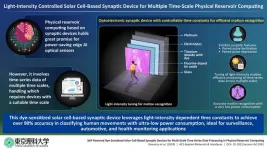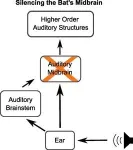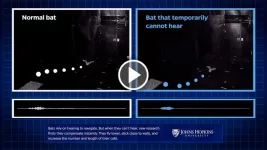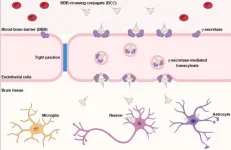Artificial intelligence (AI) is becoming increasingly useful for the prediction of emergency events such as heart attacks, natural disasters, and pipeline failures. This requires state-of-the-art technologies that can rapidly process data. In this regard, reservoir computing, specially designed for time-series data processing with low power consumption, is a promising option. It can be implemented in various frameworks, among which physical reservoir computing (PRC) is the most popular. PRC with optoelectronic artificial synapses (junction structures that permit a nerve cell to transmit an electrical or chemical signal to another cell) that mimic human synaptic elements are expected to have unparalleled recognition and real-time processing capabilities akin to the human visual system.
However, PRC based on existing self-powered optoelectronic synaptic devices cannot handle time-series data across multiple timescales, present in signals for monitoring infrastructure, natural environment, and health conditions.
In a recent breakthrough, a team of researchers from the Department of Applied Electronics, Graduate School of Advanced Engineering, Tokyo University of Science (TUS), led by Associate Professor Takashi Ikuno and including Mr. Hiroaki Komatsu, and Ms. Norika Hosoda, has successfully fabricated a self-powered dye-sensitized solar cell-based optoelectronic photopolymeric human synapse with a time constant that can be controlled by the input light intensity. Their study was published online on October 28, 2024, in the journal ACS Applied Materials & Interfaces.
Dr. Ikuno explains the motivation behind their research: “In order to process time-series input optical data with various time scales, it is essential to fabricate devices according to the desired time scale. Inspired by the afterimage phenomenon of the eye, we came up with a novel optoelectronic human synaptic device that can serve as a computational framework for power-saving edge AI optical sensors.”
The solar cell-based device utilizes squarylium derivative-based dyes and incorporates optical input, AI computation, analog output, and power supply functions in the device itself at the material level. It exhibits synaptic plasticity in response to light intensity, showing synaptic features such as paired-pulse facilitation and paired-pulse depression. The researchers demonstrated that adjusting the light intensity results in high computational performance in time-series data processing tasks, irrespective of the input light pulse width.
Furthermore, when this device was used as the reservoir layer of PRC, it classified human movements such as bending, jumping, running, and walking with more than 90% accuracy. Additionally, the power consumption was just 1% of that required by conventional systems, which would also significantly reduce the associated carbon emissions. “We have demonstrated for the first time in the world that the developed device can operate with very low power consumption and yet identify human motion with a high accuracy rate,” emphasizes Dr. Ikuno.
Notably, the proposed device opens a new path toward the realization of edge AI sensors for various time scales, with applications in surveillance cameras, car cameras, and health monitoring. According to Dr. Ikuno, “This invention can be used as a massively popular edge AI optical sensor that can be attached to any object or person, and can impact the cost involved in power consumption, such as car-mounted cameras and car-mounted computers.” He adds, “This device can function as a sensor that can identify human movement with low power consumption, and thus has the potential to contribute to the improvement of vehicle power consumption. Furthermore, it is expected to be used as a low power consumption optical sensor in stand-alone smartwatches and medical devices, significantly reducing their costs to be comparable or even lower than that of current medical devices.”
To conclude, this novel solar cell-based device has the potential to accelerate the development of energy-efficient edge AI sensors with varied applications.
***
Reference
Title of original paper: Self-Powered Dye-Sensitized Solar-Cell-Based Synaptic Devices for Multi-Scale Time-Series Data Processing in Physical Reservoir Computing
Journal: ACS Applied Materials & Interfaces
DOI: https://doi.org/10.1021/acsami.4c11061
About The Tokyo University of Science
Tokyo University of Science (TUS) is a well-known and respected university, and the largest science-specialized private research university in Japan, with four campuses in central Tokyo and its suburbs and in Hokkaido. Established in 1881, the university has continually contributed to Japan's development in science through inculcating the love for science in researchers, technicians, and educators.
With a mission of “Creating science and technology for the harmonious development of nature, human beings, and society," TUS has undertaken a wide range of research from basic to applied science. TUS has embraced a multidisciplinary approach to research and undertaken intensive study in some of today's most vital fields. TUS is a meritocracy where the best in science is recognized and nurtured. It is the only private university in Japan that has produced a Nobel Prize winner and the only private university in Asia to produce Nobel Prize winners within the natural sciences field.
Website: https://www.tus.ac.jp/en/mediarelations/
About Associate Professor Takashi Ikuno from Tokyo University of Science
Dr. Takashi Ikuno received his Ph.D. degree from Osaka University, whereupon he worked at the Lawrence Berkeley National Laboratory and UC Berkeley, USA, as a postdoctoral researcher and later at Toyota Central R&D Labs as a senior researcher. He currently holds the position of Associate Professor in the Department of Applied Electronics at the Tokyo University of Science (TUS), Japan. His research interests include developing electronic devices with nanocarbon and low-dimensional nanomaterials. Prof. Ikuno has received numerous awards, including the JSAP Poster Award and the AIP Advances Editor's Pick, both in 2024.
Funding information
The authors express their gratitude to Mr. Tatsuya Yamamoto, Mr. Naoki Kiyota, and Prof. Morio Nagata from the Tokyo University of Science for their technical support with the IPCE measurements. This work was partially supported by JST, the establishment of university fellowships towards the creation of science and technology innovation (Grant Number JPMJFS2144). Additional support was provided by JST SPRING (Grant Number JPMJSP2151).
END









